A woman on the fb group The Wildflower Society of Western Australia (Inc.) is inquiring about the little leaf lerps or scale (?) on the leaves. Any ideas?
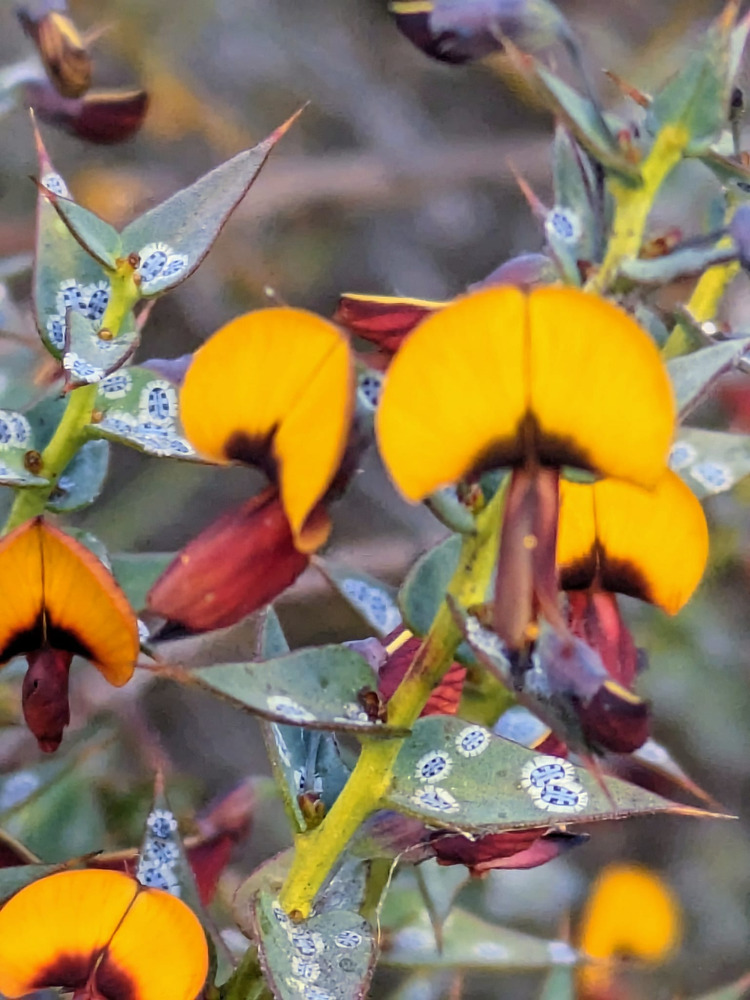
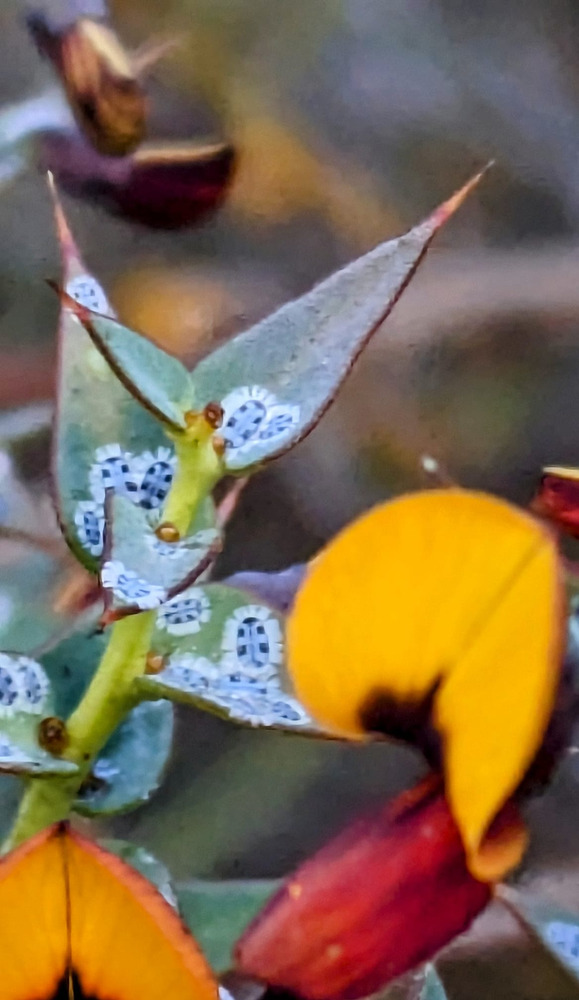
A woman on the fb group The Wildflower Society of Western Australia (Inc.) is inquiring about the little leaf lerps or scale (?) on the leaves. Any ideas?


kii said:
A woman on the fb group The Wildflower Society of Western Australia (Inc.) is inquiring about the little leaf lerps or scale (?) on the leaves. Any ideas?
By their appearance I’d say that they are scale rather than lerps. Haven’t seen this one before.
roughbarked said:
kii said:
A woman on the fb group The Wildflower Society of Western Australia (Inc.) is inquiring about the little leaf lerps or scale (?) on the leaves. Any ideas?
By their appearance I’d say that they are scale rather than lerps. Haven’t seen this one before.
and that’s the same on this facebook page. People have seen them but have no idea what they are called.
https://www.facebook.com/groups/925620167561301/
Seem too flat to be lerps?
dv said:
Seem too flat to be lerps?
Yeah. They are a scale but I haven’t found one of that shape and colour as of yet. However, if people have seen it then surely it has been described?
Quite pretty little scale insects.
roughbarked said:
roughbarked said:
kii said:
A woman on the fb group The Wildflower Society of Western Australia (Inc.) is inquiring about the little leaf lerps or scale (?) on the leaves. Any ideas?
By their appearance I’d say that they are scale rather than lerps. Haven’t seen this one before.
and that’s the same on this facebook page. People have seen them but have no idea what they are called.
https://www.facebook.com/groups/925620167561301/
That’s where I originally saw it. Trying to become aware of the new bugs and flora and fauna that I am moving to.
dv said:
Seem too flat to be lerps?
I think one suggestion on the fb page was lerps.
Isn’t Permeate Free the bug guy to consult about bugs in WA?
kii said:
roughbarked said:
roughbarked said:By their appearance I’d say that they are scale rather than lerps. Haven’t seen this one before.
and that’s the same on this facebook page. People have seen them but have no idea what they are called.
https://www.facebook.com/groups/925620167561301/
That’s where I originally saw it. Trying to become aware of the new bugs and flora and fauna that I am moving to.
You’ll be hard pushed to see this one. It seems quite specific in which plants it feeds on and those plants are now very scarce.
kii said:
dv said:
Seem too flat to be lerps?
I think one suggestion on the fb page was lerps.
Isn’t Permeate Free the bug guy to consult about bugs in WA?
He may well be if he can find it.
Has anyone asked the Australian entomology Facebook group?
Or was that from the Australian entomology Facebook group?
If unidentified there then it could be new to science.
They look like something that tweens would paint on their nails. Very pretty little pests.
roughbarked said:
kii said:
roughbarked said:and that’s the same on this facebook page. People have seen them but have no idea what they are called.
https://www.facebook.com/groups/925620167561301/
That’s where I originally saw it. Trying to become aware of the new bugs and flora and fauna that I am moving to.
You’ll be hard pushed to see this one. It seems quite specific in which plants it feeds on and those plants are now very scarce.
Are you moving to the great southern Kii?
becklefreckle said:
They look like something that tweens would paint on their nails. Very pretty little pests.roughbarked said:
kii said:That’s where I originally saw it. Trying to become aware of the new bugs and flora and fauna that I am moving to.
You’ll be hard pushed to see this one. It seems quite specific in which plants it feeds on and those plants are now very scarce.
What plant do you think they are roughbarked? I haven’t done a search yet but there are hundreds of fabaceae species with yellow/brown flowers like that. I’d be impressed if you IDed it already.Are you moving to the great southern Kii?
They reminded me of the decorations that people use on their nails.
Yes, becklefreckle, that’s my plan to move back home from the southwest of New Mexico to somewhere in the southwest of WA. The sons are living there. It’s a painful process of packing up my home here and leave memories of my husband, dogs and other critters.
Thanks for the information re: the plants.
Cool – I’m in Albany-Kinjarling, and I highly recommend it. Even if right now I have frostbite indoors.
kii said:
A woman on the fb group The Wildflower Society of Western Australia (Inc.) is inquiring about the little leaf lerps or scale (?) on the leaves. Any ideas?
The plant is Daviesia cardiophylla
https://florabase.dpaw.wa.gov.au/browse/profile/3797
The insect belongs to Hemiptera (Bugs) of which there are many. They go through stages of development with yours probably being a 1st star or crawler that will disperse the species away from their birthing area, but what they are further I have no idea and can only suggest you post them to various internet insect identification sites.
PermeateFree said:
kii said:
A woman on the fb group The Wildflower Society of Western Australia (Inc.) is inquiring about the little leaf lerps or scale (?) on the leaves. Any ideas?
The plant is Daviesia cardiophylla
https://florabase.dpaw.wa.gov.au/browse/profile/3797The insect belongs to Hemiptera (Bugs) of which there are many. They go through stages of development with yours probably being a 1st star or crawler that will disperse the species away from their birthing area, but what they are further I have no idea and can only suggest you post them to various internet insect identification sites.
OK. So shall we say it is a mealy bug?
PermeateFree said:
kii said:
A woman on the fb group The Wildflower Society of Western Australia (Inc.) is inquiring about the little leaf lerps or scale (?) on the leaves. Any ideas?
The plant is Daviesia cardiophylla
https://florabase.dpaw.wa.gov.au/browse/profile/3797The insect belongs to Hemiptera (Bugs) of which there are many. They go through stages of development with yours probably being a 1st star or crawler that will disperse the species away from their birthing area, but what they are further I have no idea and can only suggest you post them to various internet insect identification sites.
Thanks. I copied the information from a Facebook group about WA’s wildflowers, it was also posted in a similar group about WA’s insects. etc.
I’ll check back on both threads to see if any ID has come through. Internet is spotty, so it’s a tad difficult right now.
from Nick on iNat
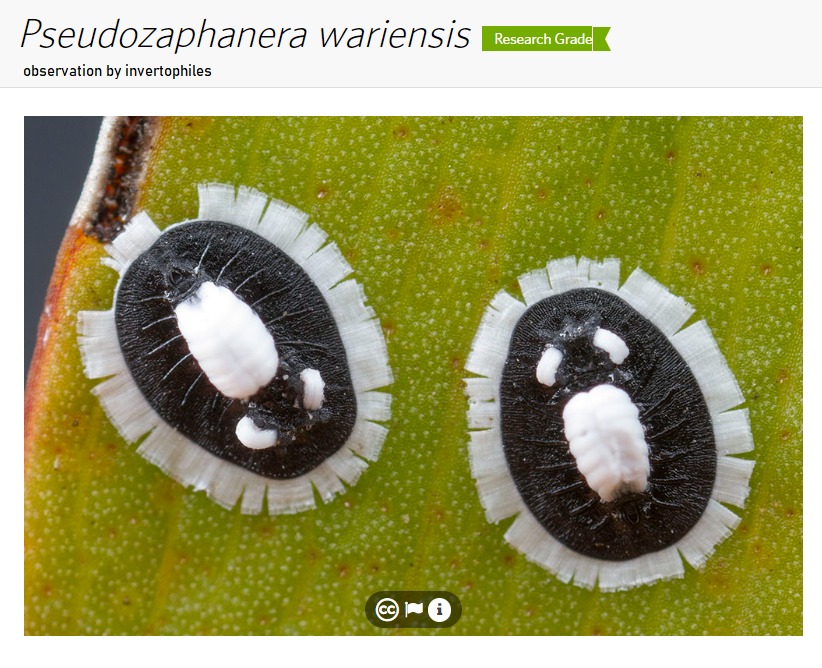
kii said:
from Nick on iNat
Thanks for that kii.
How interesting. The genus cannot be found in either Bing or Google, but I discovered Pseudozaphanera (five species) in good old Wikipedia. They are not Lerps or Scale, but a larval stage of Whitefly which is also a bug. There are in excess of 1550 species that have been described with presumably many others that have not been.
>>Whiteflies are Hemipterans that typically feed on the undersides of plant leaves. They comprise the family Aleyrodidae, the only family in the superfamily Aleyrodoidea. More than 1550 species have been described.
There generally are four larval instars. All the instars are more or less in the shape of a flattened ellipse fringed with bristles and waxy filaments. The first instar has functional legs, though short. Once it has inserted its stylets into the phloem to feed, it settles down and no longer uses its legs, and they degenerate after the first ecdysis. From then until it emerges as an adult, it remains attached to the plant by its mouthparts. The final instar feeds for a while, then undergoes changes within its skin, ceasing feeding and growing a new skin, forming what amounts to pupa. In doing so the insect does not shed the larval skin, which it retains as a protective puparium and which dries out. Meanwhile, the pupa within this skin develops into a pharate adult that usually is visible through the wall of the puparium. The puparium splits open as the imago forces its way out.
Wiki.
PermeateFree said:
kii said:from Nick on iNat
Thanks for that kii.
How interesting. The genus cannot be found in either Bing or Google, but I discovered Pseudozaphanera (five species) in good old Wikipedia. They are not Lerps or Scale, but a larval stage of Whitefly which is also a bug. There are in excess of 1550 species that have been described with presumably many others that have not been.>>Whiteflies are Hemipterans that typically feed on the undersides of plant leaves. They comprise the family Aleyrodidae, the only family in the superfamily Aleyrodoidea. More than 1550 species have been described.
There generally are four larval instars. All the instars are more or less in the shape of a flattened ellipse fringed with bristles and waxy filaments. The first instar has functional legs, though short. Once it has inserted its stylets into the phloem to feed, it settles down and no longer uses its legs, and they degenerate after the first ecdysis. From then until it emerges as an adult, it remains attached to the plant by its mouthparts. The final instar feeds for a while, then undergoes changes within its skin, ceasing feeding and growing a new skin, forming what amounts to pupa. In doing so the insect does not shed the larval skin, which it retains as a protective puparium and which dries out. Meanwhile, the pupa within this skin develops into a pharate adult that usually is visible through the wall of the puparium. The puparium splits open as the imago forces its way out.
Wiki.
Cool, thanks. I’ll copy that to the Facebook groups when I am back on the main computer.
kii said:
PermeateFree said:
kii said:from Nick on iNat
Thanks for that kii.
How interesting. The genus cannot be found in either Bing or Google, but I discovered Pseudozaphanera (five species) in good old Wikipedia. They are not Lerps or Scale, but a larval stage of Whitefly which is also a bug. There are in excess of 1550 species that have been described with presumably many others that have not been.>>Whiteflies are Hemipterans that typically feed on the undersides of plant leaves. They comprise the family Aleyrodidae, the only family in the superfamily Aleyrodoidea. More than 1550 species have been described.
There generally are four larval instars. All the instars are more or less in the shape of a flattened ellipse fringed with bristles and waxy filaments. The first instar has functional legs, though short. Once it has inserted its stylets into the phloem to feed, it settles down and no longer uses its legs, and they degenerate after the first ecdysis. From then until it emerges as an adult, it remains attached to the plant by its mouthparts. The final instar feeds for a while, then undergoes changes within its skin, ceasing feeding and growing a new skin, forming what amounts to pupa. In doing so the insect does not shed the larval skin, which it retains as a protective puparium and which dries out. Meanwhile, the pupa within this skin develops into a pharate adult that usually is visible through the wall of the puparium. The puparium splits open as the imago forces its way out.
Wiki.
Cool, thanks. I’ll copy that to the Facebook groups when I am back on the main computer.
It is all very cool info. Thanks to all.
roughbarked said:
kii said:
PermeateFree said:Thanks for that kii.
How interesting. The genus cannot be found in either Bing or Google, but I discovered Pseudozaphanera (five species) in good old Wikipedia. They are not Lerps or Scale, but a larval stage of Whitefly which is also a bug. There are in excess of 1550 species that have been described with presumably many others that have not been.>>Whiteflies are Hemipterans that typically feed on the undersides of plant leaves. They comprise the family Aleyrodidae, the only family in the superfamily Aleyrodoidea. More than 1550 species have been described.
There generally are four larval instars. All the instars are more or less in the shape of a flattened ellipse fringed with bristles and waxy filaments. The first instar has functional legs, though short. Once it has inserted its stylets into the phloem to feed, it settles down and no longer uses its legs, and they degenerate after the first ecdysis. From then until it emerges as an adult, it remains attached to the plant by its mouthparts. The final instar feeds for a while, then undergoes changes within its skin, ceasing feeding and growing a new skin, forming what amounts to pupa. In doing so the insect does not shed the larval skin, which it retains as a protective puparium and which dries out. Meanwhile, the pupa within this skin develops into a pharate adult that usually is visible through the wall of the puparium. The puparium splits open as the imago forces its way out.
Wiki.
Cool, thanks. I’ll copy that to the Facebook groups when I am back on the main computer.
It is all very cool info. Thanks to all.
Yes well we’d have to let the ALA mob know because there are only 20 records.
https://bie.ala.org.au/species/https://biodiversity.org.au/afd/taxa/7592c348-b264-4df9-abe2-067700f1cc8c
roughbarked said:
roughbarked said:
kii said:Cool, thanks. I’ll copy that to the Facebook groups when I am back on the main computer.
It is all very cool info. Thanks to all.
Yes well we’d have to let the ALA mob know because there are only 20 records.
https://bie.ala.org.au/species/https://biodiversity.org.au/afd/taxa/7592c348-b264-4df9-abe2-067700f1cc8c
Compare the photos of Pseudozaphanera wariensis on ALA with the OP photos. The OP insect may well be in that genus, but it’s not that species.
Michael V said:
roughbarked said:
roughbarked said:It is all very cool info. Thanks to all.
Yes well we’d have to let the ALA mob know because there are only 20 records.
https://bie.ala.org.au/species/https://biodiversity.org.au/afd/taxa/7592c348-b264-4df9-abe2-067700f1cc8c
Compare the photos of Pseudozaphanera wariensis on ALA with the OP photos. The OP insect may well be in that genus, but it’s not that species.
Aha. Thanks for spotting that. I was busy singning up to the ALA site to be able to use all the features.
roughbarked said:
Michael V said:
roughbarked said:Yes well we’d have to let the ALA mob know because there are only 20 records.
https://bie.ala.org.au/species/https://biodiversity.org.au/afd/taxa/7592c348-b264-4df9-abe2-067700f1cc8c
Compare the photos of Pseudozaphanera wariensis on ALA with the OP photos. The OP insect may well be in that genus, but it’s not that species.
Aha. Thanks for spotting that. I was busy singning up to the ALA site to be able to use all the features.
The ALA don’t have this species listed. So it isn’t Pseudozaphanera wariensis. Unless of course it is an instar/nymph stage that hasn’t been photographed. It isn’t any of the others listed either as far as their photos go.
As for kii and friends, maybe it should be submitted to either iNaturalist or the ALA. At least there is a better chance of a more accurate ID.
and by the way, these insects are very rarely recorded and from quite unpopulated areas. So there may be more species than we know of or we may already have killed them off before we found out what they were.
https://inaturalist.ala.org.au/
https://www.ala.org.au/
I’ll dump these references in here before I go out to do the shopping:
———————————————————————————————————————————————————————————————————————————————————-
Original description of Zaphanera rhachisreticulata Martin sp. n. This is a Western Australian species in this genus, now renamed Pseudozaphanera rhachisreticulata.
This paper includes a key to the puparia of Australian whiteflies, starting on page 11 of the document (page 17 on my pdf reader). In order to properly identify whitefly using this key, one needs to be able to examine the ventral as well as the dorsal surface.
Diagnosis and key to Zaphanera starts on page 119 of the document (p 125 on the pdf reader.)
Martin, J. H. 1999. The whitefly fauna of Australia (Sternorrhyncha: Aleyrodidae). A taxonomic account and
identification guide. Technical Paper, Division of Entomology, Commonwealth Scientific and Industrial
Research Organization, Canberra. 38: 1-197.
https://publications.csiro.au/rpr/download?pid=legacy:3409&dsid=DS1
———————————————————————————————————————————————————————————————————————————————————-
This publication includes keys, cited names and valid names for whiteflies worldwide and shows all five species on this graphic. Interestingly they are all recorded as found on Acacia, not Fabaceae (peas). Perhaps the animals show in the OP are not in this genus:
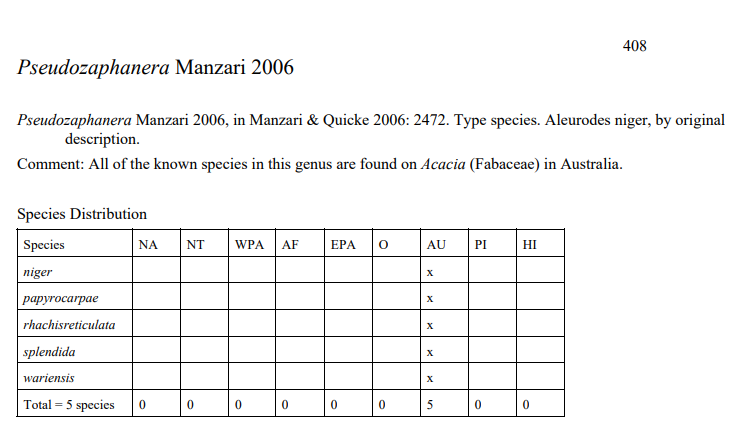
https://keys.lucidcentral.org/keys/v3/whitefly/PDF_PwP%20ETC/world-whitefly-catalog-Evans.pdf
Unfortunately the citation shown in the image above, is not in the list of references in the paper, so I haven’t been able to chase up the renaming of the genus.
———————————————————————————————————————————————————————————————————————————————————-
Atlas of Living Australia references:
https://bie.ala.org.au/search?q=Pseudozaphanera
https://bie.ala.org.au/species/https://biodiversity.org.au/afd/taxa/63b9993f-537a-41ea-ab97-9af6bfe35ce7
https://bie.ala.org.au/species/https://biodiversity.org.au/afd/taxa/b779df39-2393-4c3a-bc28-c0aef2d4f589
https://bie.ala.org.au/species/https://biodiversity.org.au/afd/taxa/606e7e18-7d3f-4df2-9289-3a2baa91e494
https://bie.ala.org.au/species/https://biodiversity.org.au/afd/taxa/2b835fc2-e25d-4fb5-9ab7-a32b70d7924d
https://bie.ala.org.au/species/https://biodiversity.org.au/afd/taxa/7592c348-b264-4df9-abe2-067700f1cc8c
https://bie.ala.org.au/species/https://biodiversity.org.au/afd/taxa/7cc04922-12f4-4fad-9940-317c5ead1359#gallery
———————————————————————————————————————————————————————————————————————————————————-
In summary, I don’t think the animal shown on the pea plant is likely to be Pseudozaphanera wariensis; it is different in dorsal pattern and is not recorded in WA. It may be the Western Australian member of this genus Pseudozaphanera rhachisreticulata, but without photos of this species and it being seen on a pea plant (not a wattle), I am not confident in this diagnosis.
I am also not confident in identifying the differences between whitefly larvae and a scale insects. I’ll work on that.
Michael V said:
I’ll dump these references in here before I go out to do the shopping:———
clipped
———————————————————————————————————————————————————————————————————————————————————-In summary, I don’t think the animal shown on the pea plant is likely to be Pseudozaphanera wariensis; it is different in dorsal pattern and is not recorded in WA. It may be the Western Australian member of this genus Pseudozaphanera rhachisreticulata, but without photos of this species and it being seen on a pea plant (not a wattle), I am not confident in this diagnosis.
I am also not confident in identifying the differences between whitefly larvae and a scale insects. I’ll work on that.
I’m not confident either. There’s a lot of them.
https://en.wikipedia.org/wiki/List_of_whitefly_species
kii said:
from Nick on iNat
Great work
PermeateFree said:
kii said:from Nick on iNat
Thanks for that kii.
How interesting. The genus cannot be found in either Bing or Google,
Got to say, the genus was known to Google when I Googled it.

dv said:
PermeateFree said:
kii said:from Nick on iNat
Thanks for that kii.
How interesting. The genus cannot be found in either Bing or Google,
Got to say, the genus was known to Google when I Googled it.
Yes, rather strange that the full species name is listed, but the genus is not.
PermeateFree said:
dv said:
PermeateFree said:Thanks for that kii.
How interesting. The genus cannot be found in either Bing or Google,
Got to say, the genus was known to Google when I Googled it.
Yes, rather strange that the full species name is listed, but the genus is not.
They look like photos of structures taken from the sky
roughbarked said:
Michael V said:
I’ll dump these references in here before I go out to do the shopping:———
clipped
———————————————————————————————————————————————————————————————————————————————————-In summary, I don’t think the animal shown on the pea plant is likely to be Pseudozaphanera wariensis; it is different in dorsal pattern and is not recorded in WA. It may be the Western Australian member of this genus Pseudozaphanera rhachisreticulata, but without photos of this species and it being seen on a pea plant (not a wattle), I am not confident in this diagnosis.
I am also not confident in identifying the differences between whitefly larvae and a scale insects. I’ll work on that.
I’m not confident either. There’s a lot of them.
https://en.wikipedia.org/wiki/List_of_whitefly_species
From my earlier post:
>>There generally are four larval instars. All the instars are more or less in the shape of a flattened ellipse fringed with bristles and waxy filaments.<<
Obviously not Pseudozaphanera wariensis, but maybe Pseudozaphanera rhachisreticulata, as that species occurs in the same district as the host plant.
With such a poorly known insect genus, let alone noted and collected, you would not want to be certain of the host plants, as Acacia might have been the most obvious host as these larvae generally feed on the underside of the leaf. The photo supplied of them on the upper side of the Daviesia might have been taken at the first instar larval stage when they were moving around.
PermeateFree said:
roughbarked said:
Michael V said:
I’ll dump these references in here before I go out to do the shopping:———
clipped
———————————————————————————————————————————————————————————————————————————————————-In summary, I don’t think the animal shown on the pea plant is likely to be Pseudozaphanera wariensis; it is different in dorsal pattern and is not recorded in WA. It may be the Western Australian member of this genus Pseudozaphanera rhachisreticulata, but without photos of this species and it being seen on a pea plant (not a wattle), I am not confident in this diagnosis.
I am also not confident in identifying the differences between whitefly larvae and a scale insects. I’ll work on that.
I’m not confident either. There’s a lot of them.
https://en.wikipedia.org/wiki/List_of_whitefly_species
From my earlier post:
>>There generally are four larval instars. All the instars are more or less in the shape of a flattened ellipse fringed with bristles and waxy filaments.<<
Obviously not Pseudozaphanera wariensis, but maybe Pseudozaphanera rhachisreticulata, as that species occurs in the same district as the host plant.
With such a poorly known insect genus, let alone noted and collected, you would not want to be certain of the host plants, as Acacia might have been the most obvious host as these larvae generally feed on the underside of the leaf. The photo supplied of them on the upper side of the Daviesia might have been taken at the first instar larval stage when they were moving around.
Interesting thoughts. Not a very often observed insect by the looks.
roughbarked said:
PermeateFree said:
roughbarked said:I’m not confident either. There’s a lot of them.
https://en.wikipedia.org/wiki/List_of_whitefly_species
From my earlier post:
>>There generally are four larval instars. All the instars are more or less in the shape of a flattened ellipse fringed with bristles and waxy filaments.<<
Obviously not Pseudozaphanera wariensis, but maybe Pseudozaphanera rhachisreticulata, as that species occurs in the same district as the host plant.
With such a poorly known insect genus, let alone noted and collected, you would not want to be certain of the host plants, as Acacia might have been the most obvious host as these larvae generally feed on the underside of the leaf. The photo supplied of them on the upper side of the Daviesia might have been taken at the first instar larval stage when they were moving around.
Interesting thoughts. Not a very often observed insect by the looks.
Certainly not the larval stages.
PermeateFree said:
roughbarked said:
Michael V said:
I’ll dump these references in here before I go out to do the shopping:———
clipped
———————————————————————————————————————————————————————————————————————————————————-In summary, I don’t think the animal shown on the pea plant is likely to be Pseudozaphanera wariensis; it is different in dorsal pattern and is not recorded in WA. It may be the Western Australian member of this genus Pseudozaphanera rhachisreticulata, but without photos of this species and it being seen on a pea plant (not a wattle), I am not confident in this diagnosis.
I am also not confident in identifying the differences between whitefly larvae and a scale insects. I’ll work on that.
I’m not confident either. There’s a lot of them.
https://en.wikipedia.org/wiki/List_of_whitefly_species
From my earlier post:
>>There generally are four larval instars. All the instars are more or less in the shape of a flattened ellipse fringed with bristles and waxy filaments.<<
Obviously not Pseudozaphanera wariensis, but maybe Pseudozaphanera rhachisreticulata, as that species occurs in the same district as the host plant.
With such a poorly known insect genus, let alone noted and collected, you would not want to be certain of the host plants, as Acacia might have been the most obvious host as these larvae generally feed on the underside of the leaf. The photo supplied of them on the upper side of the Daviesia might have been taken at the first instar larval stage when they were moving around.
Sure.
Michael V said:
PermeateFree said:
roughbarked said:I’m not confident either. There’s a lot of them.
https://en.wikipedia.org/wiki/List_of_whitefly_species
From my earlier post:
>>There generally are four larval instars. All the instars are more or less in the shape of a flattened ellipse fringed with bristles and waxy filaments.<<
Obviously not Pseudozaphanera wariensis, but maybe Pseudozaphanera rhachisreticulata, as that species occurs in the same district as the host plant.
With such a poorly known insect genus, let alone noted and collected, you would not want to be certain of the host plants, as Acacia might have been the most obvious host as these larvae generally feed on the underside of the leaf. The photo supplied of them on the upper side of the Daviesia might have been taken at the first instar larval stage when they were moving around.
Sure.
>>There generally are four larval instars. All the instars are more or less in the shape of a flattened ellipse fringed with bristles and waxy filaments.<<
The above is a characteristic of the larval stage of these insects. If you look closely at lerp or scale larvae, they do not have that characteristic.
Oooh!
I’ve just found the unreferenced paper that renames the genus Pseudozaphanera Manzari gen. n.
A cladistic analysis of whiteflies, subfamily Aleyrodinae (Hemiptera: Sternorrhyncha: Aleyrodidae)
Shahab Manzari &Donald L. J. Quicke
It’s a download at this site, found by a google search of Pseudozaphanera rhachisreticulata:

Interestingly, its host family is listed as Fabaceae.

Michael V said:
Oooh!I’ve just found the unreferenced paper that renames the genus Pseudozaphanera Manzari gen. n.
A cladistic analysis of whiteflies, subfamily Aleyrodinae (Hemiptera: Sternorrhyncha: Aleyrodidae)
Shahab Manzari &Donald L. J. Quicke
It’s a download at this site, found by a google search of Pseudozaphanera rhachisreticulata:
Interestingly, its host family is listed as Fabaceae.
There you go.
PermeateFree said:
Michael V said:
Oooh!I’ve just found the unreferenced paper that renames the genus Pseudozaphanera Manzari gen. n.
A cladistic analysis of whiteflies, subfamily Aleyrodinae (Hemiptera: Sternorrhyncha: Aleyrodidae)
Shahab Manzari &Donald L. J. Quicke
It’s a download at this site, found by a google search of Pseudozaphanera rhachisreticulata:
Interestingly, its host family is listed as Fabaceae.
There you go.
The only good bug is a dead bug
Anyway, here is Martin’s original diagnosis of Zaphanera rhachisreticulata from the 1999 CSIRO paper web-referenced below:
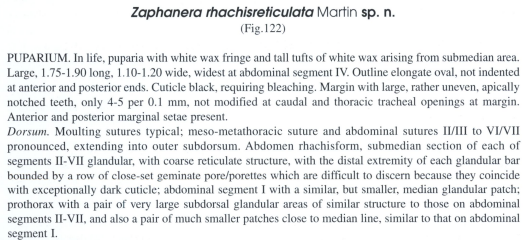



https://publications.csiro.au/rpr/download?pid=legacy:3409&dsid=DS1
Brain was dead. I had forgotten that Acacia is in Fabaceae.
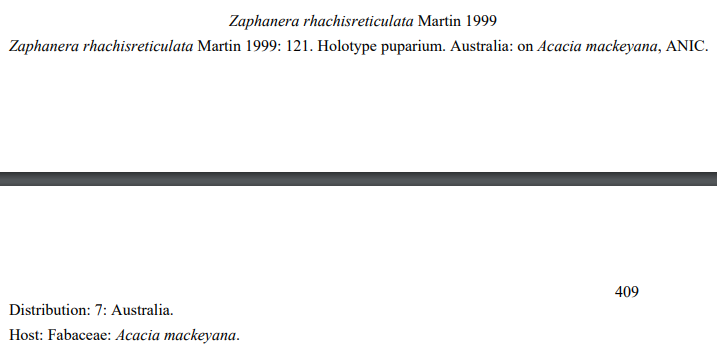
https://keys.lucidcentral.org/keys/v3/whitefly/PDF_PwP%20ETC/world-whitefly-catalog-Evans.pdf
Michael V said:
>>All of the known species in this genus are found on Acacia (Fabaceae) in Australia.<<
Brain was dead. I had forgotten that Acacia is in Fabaceae.
https://keys.lucidcentral.org/keys/v3/whitefly/PDF_PwP%20ETC/world-whitefly-catalog-Evans.pdf
Maybe poorly collected or a different species. There are many new flora species collected every year, so with invertebrates and at instar stage the mind boggles at how many might be out there yet to be discovered.
——————————————————————————————————————
>>There are so many invertebrates on this planet that it is impossible to count them all. They come in many shapes and sizes, live practically anywhere and provide many services that are vital for our survival.
Invertebrates have been recorded in the upper reaches of the atmosphere, in the driest of deserts and in the canopies of the wettest rainforests. They can even be found in the frozen Antarctic (some mites and springtails can withstand temperatures of -35°C) or on the ocean floor of the Abyssal Sea which reaches depths of up to 11 000 metres.
Invertebrates are all around us and yet amazingly most go about their daily business unnoticed. Much of this has to do with the size of invertebrates. On land, invertebrates range from fractions of a millimetre to approximately 150 centimetres in length, though most are less than five centimetres. Their size allows them to occupy large habitats such as deserts and rainforests as well as many microhabitats, which may not be visible to the eye. For example, they maybe found in a pool of water in a pitcher plant, the follicles of a hair, or inside a seed.
—————————————————————————————————————
>>It is estimated that Australia has 275 000 to 300 000 species of invertebrates that live on land. Many of these species are endemic to Australia (not found anywhere else in the world).
More than 80% of all the cicadas, leafhoppers, true bugs and ants found in Australia are endemic. The high level of endemism is attributed to a number of factors:
Australia has a long geological history of isolation from other continents.
Australia is large and consequently has a wide range of habitats including tropical, temperate, semi-arid and arid regions.
Australia has a landscape dominated by many different species of endemic flora. Invertebrates have exploited the many food sources and niches that these plants offer. As a result it is estimated that a third of all foliage feeding insects in Australia depend on our native Eucalypts and Acacias.
Despite the uniqueness of Australian invertebrates we unfortunately know little about them.
Scientists believe that less than 15% of our invertebrates have been formally described. This is concerning when we consider the current rate of habitat destruction in this country. Through the removal of these precious habitats we maybe destroying countless species of invertebrates that we are not aware of.
https://australian.museum/learn/teachers/learning/what-are-invertebrates/
Wowsers…..so much information. So little time and/or brain power to read it all. So much internet connection dropping out.
I posted a link to this forum with a note that much discussion has taken place.
PermeateFree said:
Michael V said:>>All of the known species in this genus are found on Acacia (Fabaceae) in Australia.<<
Brain was dead. I had forgotten that Acacia is in Fabaceae.
https://keys.lucidcentral.org/keys/v3/whitefly/PDF_PwP%20ETC/world-whitefly-catalog-Evans.pdf
Maybe poorly collected or a different species. There are many new flora species collected every year, so with invertebrates and at instar stage the mind boggles at how many might be out there yet to be discovered.
——————————————————————————————————————>>There are so many invertebrates on this planet that it is impossible to count them all. They come in many shapes and sizes, live practically anywhere and provide many services that are vital for our survival.
Invertebrates have been recorded in the upper reaches of the atmosphere, in the driest of deserts and in the canopies of the wettest rainforests. They can even be found in the frozen Antarctic (some mites and springtails can withstand temperatures of -35°C) or on the ocean floor of the Abyssal Sea which reaches depths of up to 11 000 metres.
Invertebrates are all around us and yet amazingly most go about their daily business unnoticed. Much of this has to do with the size of invertebrates. On land, invertebrates range from fractions of a millimetre to approximately 150 centimetres in length, though most are less than five centimetres. Their size allows them to occupy large habitats such as deserts and rainforests as well as many microhabitats, which may not be visible to the eye. For example, they maybe found in a pool of water in a pitcher plant, the follicles of a hair, or inside a seed.
—————————————————————————————————————>>It is estimated that Australia has 275 000 to 300 000 species of invertebrates that live on land. Many of these species are endemic to Australia (not found anywhere else in the world).
More than 80% of all the cicadas, leafhoppers, true bugs and ants found in Australia are endemic. The high level of endemism is attributed to a number of factors:
Australia has a long geological history of isolation from other continents.
Australia is large and consequently has a wide range of habitats including tropical, temperate, semi-arid and arid regions.
Australia has a landscape dominated by many different species of endemic flora. Invertebrates have exploited the many food sources and niches that these plants offer. As a result it is estimated that a third of all foliage feeding insects in Australia depend on our native Eucalypts and Acacias.
Despite the uniqueness of Australian invertebrates we unfortunately know little about them.Scientists believe that less than 15% of our invertebrates have been formally described. This is concerning when we consider the current rate of habitat destruction in this country. Through the removal of these precious habitats we maybe destroying countless species of invertebrates that we are not aware of.
https://australian.museum/learn/teachers/learning/what-are-invertebrates/
Yes. The war on nature should be brought to an end.
A well known nurseryman told me that most native plants are ugly and that planting them only encouraged pests. Well I know that he was wrong. Obviously native plants are beautiful food to invertebrates among many of our more well known unique animals.
Michael V said:
Brain was dead. I had forgotten that Acacia is in Fabaceae.
https://keys.lucidcentral.org/keys/v3/whitefly/PDF_PwP%20ETC/world-whitefly-catalog-Evans.pdf
Acacia is part of the large and highly diverse Fabaceae (Legume) family, but depending on the classification system in use, may also be listed under Mimosaceae or Leguminosae.